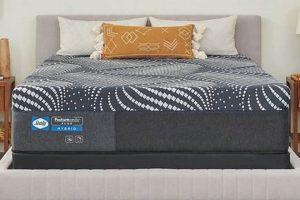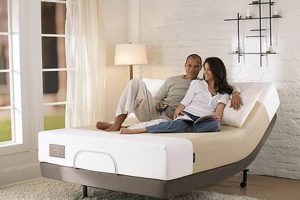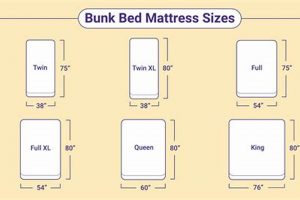An inclined plane, designed to be positioned beneath a mattress, elevates the upper body or legs. This support mechanism provides a gradual slope, offering an alternative to stacking pillows. Its purpose is to alleviate specific physical discomforts through postural adjustment during rest.
Utilizing an inclined support structure can mitigate symptoms associated with acid reflux, sleep apnea, and certain respiratory conditions. The elevation promotes improved breathing and reduces pressure on the digestive system. Historically, individuals have sought elevation solutions during sleep to address these ailments, with the modern form offering a more consistent and stable approach.
The following sections will delve into the materials, dimensions, selection criteria, and care considerations relevant to inclined mattress supports, offering comprehensive guidance for informed purchase and effective utilization.
Guidance on Inclined Mattress Supports
The following guidance aims to provide informational points for maximizing the potential benefits of an inclined support system for a mattress.
Tip 1: Material Selection: Consider the density and composition of the support material. High-density foam provides firm support, while memory foam conforms to body contours. Hypoallergenic materials are advisable for sensitive individuals.
Tip 2: Incline Angle: A gradual incline of 6 to 8 inches is generally recommended for addressing acid reflux. Steeper inclines may be necessary for specific respiratory needs, but should be evaluated for comfort and spinal alignment.
Tip 3: Dimensions and Fit: Measure the width of the mattress to ensure the support spans the entire sleeping surface, preventing unevenness and potential discomfort.
Tip 4: Cover Material: Opt for a removable and washable cover to maintain hygiene. Breathable fabrics, such as cotton or bamboo, enhance airflow and prevent overheating.
Tip 5: Gradual Adjustment: Introduce the inclined support gradually to allow the body to adapt to the new sleeping position. Start with a lower incline and increase as needed.
Tip 6: Proper Placement: Ensure the support is positioned securely beneath the mattress, preventing slippage or movement during the night. Utilizing a non-slip mat underneath may be beneficial.
Tip 7: Consider Physician Advice: Consult with a healthcare professional for personalized recommendations regarding the appropriate incline and usage of an inclined mattress support, particularly if addressing a specific medical condition.
Effective utilization of an inclined mattress support relies on careful consideration of material, dimensions, incline angle, and adherence to proper placement techniques. This ensures optimal comfort and therapeutic benefit.
The succeeding portion of this article will address cleaning and maintenance for prolonged lifespan.
1. Incline
The incline is the defining characteristic of a mattress elevation support, functionally differentiating it from a flat surface. Without the presence of a slope, the device would not fulfill its primary purpose of elevating the upper body or legs. The degree of this slope, measured in inches of rise over the length of the device, directly impacts the physiological effects experienced by the user.
For instance, a gradual incline of six to eight inches is commonly recommended to mitigate acid reflux symptoms. This elevation leverages gravity to reduce the likelihood of stomach acid traveling up the esophagus. Conversely, individuals with specific respiratory conditions may require a steeper incline to facilitate improved airflow. In either case, the selected incline dictates the level of therapeutic benefit derived from the device. Failure to achieve an adequate incline renders the device ineffective for its intended purpose. Selecting incorrect degree, steep or low, may cause discomfort.
In conclusion, the incline is not merely a physical attribute; it is the foundational element that determines the functionality and efficacy of a mattress elevation support. Understanding the relationship between incline and specific medical conditions is crucial for selecting an appropriate device and achieving the desired therapeutic outcomes. In summary, an insufficient or inappropriate incline negates the intended advantages, transforming a potentially beneficial support into an ineffective item.
2. Material
Material composition is a critical determinant of the functionality, comfort, and longevity of a mattress incline support. The selection of materials directly impacts its ability to provide adequate support, maintain its shape over time, and cater to individual user needs and sensitivities.
- Foam Density
Foam density is a primary factor influencing the support provided. High-density foam offers firm support, resisting compression and maintaining the intended incline over extended use. Low-density foam, while potentially more comfortable initially, is prone to sagging and deformation, diminishing its therapeutic effectiveness. A high density should be selected to provide support without sacrificing shape.
- Foam Type
Various foam types, including memory foam, polyurethane foam, and latex foam, each offer distinct characteristics. Memory foam conforms to body contours, providing pressure relief but potentially retaining heat. Polyurethane foam is a cost-effective option, offering a balance of support and comfort. Latex foam is a durable and hypoallergenic choice, known for its breathability and resilience. Each foam comes with its own advantage and disadvantage.
- Cover Fabric
The cover material plays a crucial role in hygiene and comfort. Breathable fabrics, such as cotton or bamboo, promote airflow and prevent moisture buildup. Removable and washable covers are essential for maintaining cleanliness and preventing the accumulation of allergens or bacteria. Certain fabrics will enhance or hinder the experience of comfort.
- Hypoallergenic Properties
For individuals with allergies or sensitivities, hypoallergenic materials are paramount. Latex foam, some polyurethane foams, and specific cover fabrics are treated to minimize allergen retention. Certifications, such as OEKO-TEX, ensure that materials are free from harmful substances. The hypoallergenic properties can lead to better sleep.
The interplay between foam density, foam type, cover fabric, and hypoallergenic properties defines the overall performance and suitability of a mattress incline support. Selecting materials appropriate for individual needs and preferences is crucial for maximizing therapeutic benefits and ensuring long-term user satisfaction.
3. Dimensions
The dimensions of a mattress incline support are critical to its functionality and user comfort. Incorrect dimensions can negate the intended benefits, rendering the support ineffective or even detrimental to spinal alignment. The width, length, and height (incline) of the support must be carefully considered in relation to the mattress size and individual user needs. For instance, a support that is too narrow will create an uneven sleeping surface, potentially leading to back pain or discomfort. A support that is too long may extend beyond the edge of the bed frame, creating a tripping hazard. Dimensions are not merely measurements; they are integral to function.
The incline height, specifically, dictates the degree of elevation provided. As previously discussed, a gradual incline is typically recommended for acid reflux, while steeper inclines may be necessary for respiratory conditions. However, the length of the support must also be proportional to the incline height. A short support with a steep incline will create an abrupt angle, potentially causing discomfort in the lower back. Conversely, a long support with a shallow incline may not provide sufficient elevation to achieve the desired therapeutic effect. The relationship and understanding between length and incline ensures the desired function.
In conclusion, the dimensions of a mattress elevation support are not arbitrary values; they are interconnected parameters that directly influence its performance and suitability. Accurate measurements and careful consideration of mattress size and individual needs are essential for selecting a support that provides optimal comfort, support, and therapeutic benefit. Overlooking the dimensional aspect risks compromising the effectiveness of the entire system. Proper dimension enables correct spinal position which supports the function.
4. Support
The term “support,” in the context of a mattress incline mechanism, encompasses the structural attributes enabling it to fulfill its intended function. Without adequate supportive characteristics, the mechanism is rendered ineffective. Support is essential for maintaining the intended incline angle, distributing weight evenly, and ensuring user comfort and safety. Proper support also contributes to the overall longevity of the device. This section explores key facets of support within this context.
- Density of Core Material
The density of the core material, typically foam, directly dictates the level of support provided. High-density foams resist compression, maintaining the incline angle under the user’s weight. Insufficient density results in sagging, compromising the intended elevation and potentially leading to discomfort or spinal misalignment. For instance, a high-density polyurethane foam core is more likely to provide consistent support compared to a low-density option. High density can ensure proper alignment is supported.
- Weight Distribution Capacity
An effective support structure distributes the user’s weight evenly across its surface. Uneven weight distribution can create pressure points, leading to discomfort and potentially affecting circulation. Reinforced designs, incorporating features such as internal bracing or multi-layer construction, enhance weight distribution capacity. Proper weight distribution prevents localized stress and promotes comfortable support. Proper weight distribution will ensure that proper blood flow is maintained.
- Structural Integrity and Durability
Structural integrity refers to the ability of the support to withstand repeated use and maintain its shape over time. Durable construction, utilizing high-quality materials and robust manufacturing processes, is essential for long-term performance. Indicators of structural integrity include resistance to tearing, cracking, or deformation under stress. A well-constructed wedge ensures consistent support over extended periods. Durability will ensure that the item will last for its entire intended life cycle.
- Surface Friction and Stability
The surface friction between the support and the mattress, and between the support and the bed frame, contributes to overall stability. Sufficient friction prevents the support from shifting or sliding during use, which could compromise the incline angle and potentially lead to falls. Non-slip materials or textured surfaces enhance surface friction and improve stability. Enhanced stability ensures a safe and secure sleeping environment. Stability is also a great element to have for ensuring safety.
These facets of support are interconnected, collectively determining the effectiveness and longevity of a mattress incline mechanism. The selection of appropriate materials, robust construction techniques, and attention to surface properties are all crucial for ensuring that the device provides adequate support, promotes user comfort, and maintains its intended function over time. Without this support, the item would lose its effectiveness.
5. Hygiene
Maintaining hygiene within the context of a mattress incline mechanism is paramount due to its direct contact with bedding and prolonged exposure to the user. The potential for accumulation of allergens, bacteria, and bodily fluids necessitates a focus on materials and design features that facilitate cleanliness and prevent the propagation of harmful microorganisms. Effective hygiene practices extend the lifespan of the support and promote user health.
- Material Permeability and Breathability
The permeability of the core material and cover fabric influences moisture retention and airflow. Non-breathable materials trap moisture, creating a breeding ground for bacteria and mold. Breathable fabrics, such as cotton or bamboo, promote airflow and reduce moisture buildup. Impermeable materials necessitate frequent cleaning and may require additional protective layers. Proper ventilation is essential to prohibit the growth of harmful bacteria, mold, and allergens.
- Removable and Washable Covers
Removable covers facilitate regular cleaning and disinfection. Washable covers allow for the removal of accumulated allergens, dust mites, and bodily fluids. Zippers or other fastening mechanisms should be durable and easy to operate. The absence of a removable and washable cover significantly complicates the cleaning process and increases the risk of contamination. Regular cleaning ensures the cleanliness of the support for the duration of its use.
- Antimicrobial Treatments and Materials
Antimicrobial treatments inhibit the growth of bacteria, fungi, and other microorganisms. Materials infused with antimicrobial agents provide an additional layer of protection against contamination. However, the long-term effectiveness of antimicrobial treatments may vary depending on the specific agent and usage conditions. Choosing to go with antimicrobial material will add additional protection against allergen build-up.
- Cleaning Protocols and Maintenance
Regular cleaning protocols are essential for maintaining hygiene. This includes vacuuming the support surface to remove dust and debris, spot cleaning stains with appropriate cleaning agents, and periodically laundering the cover according to manufacturer instructions. Neglecting
regular cleaning can lead to the accumulation of allergens and the proliferation of harmful microorganisms. Following cleaning protocol is also essential for prolonged usage.
The interplay between material selection, design features, and cleaning protocols dictates the overall hygienic quality of a mattress incline mechanism. Prioritizing breathable materials, removable covers, and regular cleaning practices minimizes the risk of contamination and promotes a healthy sleeping environment. These practices ultimately contribute to the longevity and effectiveness of the device, ensuring that it continues to provide therapeutic benefit without compromising user well-being.
6. Positioning
The effectiveness of a mattress incline mechanism is intrinsically linked to its positioning beneath the mattress. Placement dictates the distribution of support, the resultant incline angle, and ultimately, the therapeutic benefit derived by the user. Incorrect placement compromises the intended functionality, potentially exacerbating the conditions it is designed to alleviate. The support structure must be positioned accurately to provide uniform elevation across the targeted area of the mattress. For example, if the goal is to alleviate acid reflux, the incline support must elevate the upper torso, commencing beneath the shoulders, to leverage gravity effectively. Improper positioning, such as placing the support too low beneath the mattress, fails to deliver the necessary elevation, rendering the mechanism ineffective. The end-user must ensure proper placement for its intended purpose.
Proper positioning extends beyond simply placing the incline support under the mattress; it involves ensuring the support is flush with the mattress edge and securely anchored to prevent slippage. Shifting or sliding of the support during sleep can create an uneven sleeping surface, leading to discomfort and disrupting spinal alignment. In cases where individuals utilize adjustable bed frames, the incline mechanism must be positioned in conjunction with the frame’s articulation to maintain a consistent and supportive incline. The surface of contact must also be taken into consideration. Securing the support to reduce the possibility of movement is essential for preserving both its therapeutic benefits and the user’s safety.
In conclusion, optimal positioning is not merely a preliminary step in utilizing a mattress incline mechanism; it is an ongoing process that demands attention to detail and periodic adjustments. The correct placement ensures consistent elevation, maintains spinal alignment, and maximizes the potential therapeutic benefits. Overlooking the significance of precise positioning diminishes the overall effectiveness of the incline support, transforming it from a therapeutic tool into an ineffective component. Proper positioning will also provide long-lasting support.
Frequently Asked Questions
The following section addresses common inquiries regarding the selection, utilization, and maintenance of mattress incline supports.
Question 1: What conditions benefit from the use of a mattress incline support?
Elevating the upper body or legs through the use of a mattress incline support can alleviate symptoms associated with acid reflux, sleep apnea, respiratory issues, and edema. Consultation with a medical professional is advised to determine suitability.
Question 2: What is the recommended incline angle for acid reflux relief?
A gradual incline of 6 to 8 inches is generally recommended to mitigate acid reflux symptoms. Adjustments may be necessary based on individual comfort and response.
Question 3: How wide should a mattress incline support be?
The support should span the entire width of the mattress to ensure even weight distribution and prevent unevenness. Measure the mattress prior to purchase.
Question 4: What materials are best for individuals with allergies?
Hypoallergenic materials, such as latex foam or certain polyurethane foams with antimicrobial treatments, are advisable for sensitive individuals. Cover fabrics should also be hypoallergenic and easily washable.
Question 5: How is a mattress incline support properly cleaned?
Removable covers should be laundered according to the manufacturer’s instructions. The support surface can be vacuumed to remove dust and debris, and spot cleaned as needed. Harsh chemicals are generally not recommended.
Question 6: Can a mattress incline support be used with an adjustable bed frame?
Yes, but careful positioning is required to ensure the support remains aligned with the bed frame’s articulation, maintaining a consistent incline angle.
In summary, understanding the appropriate incline angle, material composition, dimensions, and hygiene practices is essential for maximizing the benefits of a mattress incline support.
The subsequent segment will address potential drawbacks and contraindications associated with the use of these supports.
Conclusion
This exploration of the bed wedge for under mattress has emphasized the importance of incline, material selection, dimensions, support characteristics, hygiene maintenance, and proper positioning. These elements critically influence the device’s efficacy in alleviating specific conditions and ensuring user comfort. Neglecting any of these factors diminishes the potential therapeutic benefits.
The responsible utilization of a bed wedge for under mattress requires informed consideration of individual needs and adherence to recommended practices. Further research and consultation with healthcare professionals are encouraged to ensure optimal outcomes and responsible application of this assistive device.



![Best Queen Adjustable Bed & Mattress [Guide & Reviews] Organic & Natural Mattress Buyer’s Guide: Non-Toxic Sleep Solutions Best Queen Adjustable Bed & Mattress [Guide & Reviews] | Organic & Natural Mattress Buyer’s Guide: Non-Toxic Sleep Solutions](https://mattressworldpa.com/wp-content/uploads/2025/07/th-7128-300x200.jpg)



